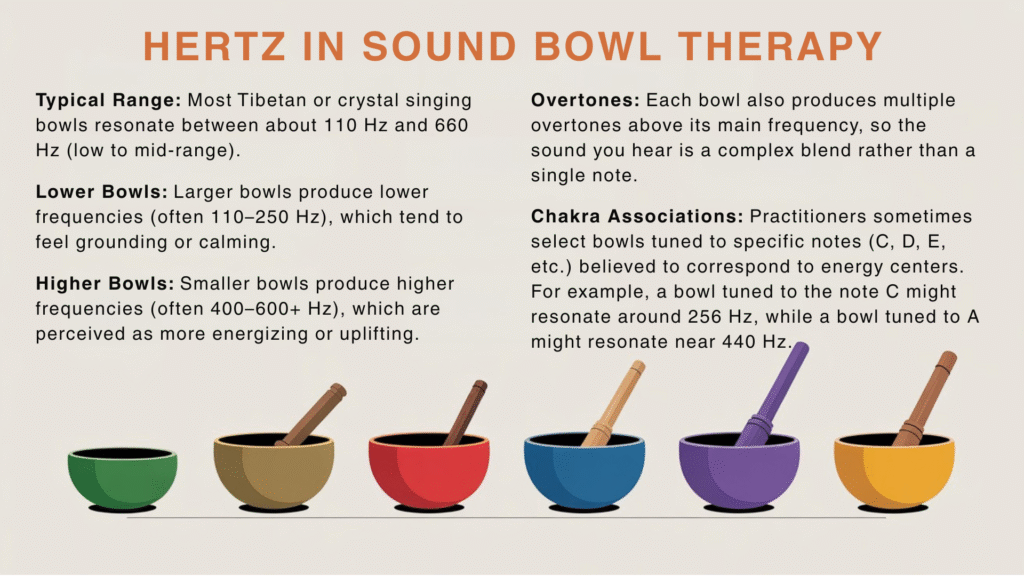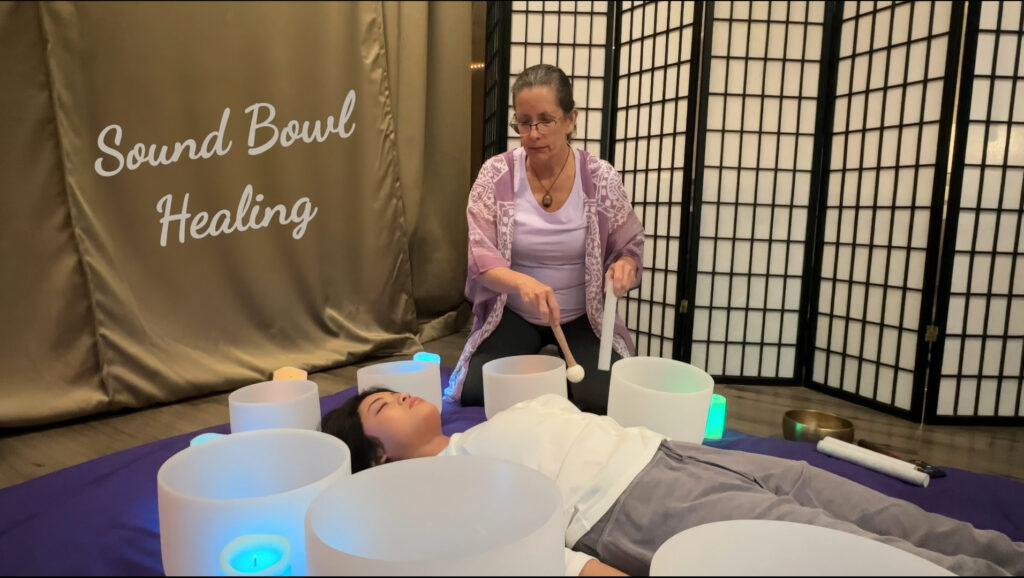Singing Bowl Sound and Massage Healing
Singing Bowl Sound and Massage Healing help us relax in a busy world. These practices not only promote deep relaxation but also offer a range of surprising benefits for both the mind and body. The soothing vibrations of sound bowls can help to reduce stress and anxiety, creating a calming environment that enhances the overall massage experience. When combined, sound therapy and massage can improve circulation, relieve muscle tension, and enhance emotional well-being, making it a powerful tool for holistic healing. Embracing these therapies can lead to a greater sense of balance and tranquility in our hectic lives.
Sound bath sessions use singing bowls and other instruments. They create sounds that help us relax and focus when we’re stressed.
What Is a Sound Bath and Singing Bowl Therapy?
A sound bath invites listeners to lie still while layers of sustained tones wash through a dim, comfortable room.
Definition and setup: A sound bath is a listening practice where bowls and instruments fill a room with sounds. People lie down with their eyes closed as a practitioner plays the instruments.
How immersion works: The practitioner makes sounds that blend together. Dim lights and mats help the body relax and focus.
Origins and context: This therapy comes from ancient practices, but its exact origins are unclear. Now, it’s used in wellness centers and some studies to reduce stress.
Sessions can be for groups or individuals. They might include breathing exercises to help everyone relax.
Tibetan Singing Bowls vs. Crystal Singing Bowls
Metal and quartz instruments serve different roles in practice. Metal bowls create warm tones that help with meditation. Quartz bowls are clear and precise, great for focused work.
Tonal qualities and feel
Tibetan singing bowls are made of metal and have deep, rich tones. They fill a room with sound.
Crystal singing bowls are made of quartz and have a clear, bell-like sound. They’re good for precise work on energy centers.
Choosing for meditation, chakra work, or group sessions
Practitioners often mix metal and crystal bowls for a balanced sound. Crystal bowls are chosen for chakra work because of their specific tones.
While metal bowls are linked to Tibetan traditions, they’re used worldwide. The best bowl is the one that helps you relax and focus.
How Sound Therapy Works: Vibrations, Frequencies, and the Body
This part outlines how sustained acoustic pulses guide brain activity and bodily responses toward rest.
Brainwave entrainment: shifting into alpha and theta states
Steady tones in a session help the brain follow simple patterns. This can move brain activity from busy to calm states.
Activating the parasympathetic nervous system for deep relaxation
Listening to the tones and breathing deeply engages the parasympathetic nervous system. This can lower heart rate and blood pressure, helping us relax.
Different bowls are tuned to different pitches and overtones. Here’s how it breaks down:

Research shows singing bowl therapy can change brain activity. It’s a good addition to other self-care, not a replacement for medical care.
Singing Bowl Sound and Massage Healing Benefits
People often feel less nervous and clearer after listening. Many report less anxiety and a steadier mood after sessions.
Mental and emotional well-being: Sessions can reduce anxiety and depression. People feel more calm and can handle daily life better.
Physiological effects: Sessions can lower blood pressure and heart rate. They can also improve breathing and sleep.
Meditation enhancement: The sound helps focus and calm the mind. It can make meditation more effective.
Practical note: Results vary. Short, regular sessions can help over time. They can improve health routines.
Integrating Singing Bowls with Massage and Spa Treatments
Using singing bowls with massage creates a calm bridge. Practitioners in spas use sound to help clients relax before touch.
How practitioners use bowls on and around the body
A practitioner will strike a bowl and hold it over the body. This lets vibrations reach soft tissue while strokes continue.
Therapists adjust volume and distance to avoid too much stimulation. They fit brief tones into sessions without making them longer.
What clients report: muscle relaxation, circulation, and balance
Clients often feel less tension and better breathing. They say energy feels freer. Many sleep better and feel balanced after.
Using bowls with gentle strokes improves circulation and softens muscles. This adds a calming touch to spa treatments.
What to Expect in a Sound Bath or Singing Bowl Session
A session starts with a quiet room and soft lighting. People settle on mats as the practitioner explains the session.
Before: The facilitator talks about what to expect and how to adjust for comfort. This helps newcomers relax fast.
During: The room fills with sound. People might feel tingling or see images. They often feel calm within 20 minutes.
After: After the sound stops, people rest and then slowly sit up. They drink water and often feel clearer and less stressed.
Practical tips
First-timers should keep it simple. Just observe and feel. Tell the facilitator if you’re sensitive. Regular sessions can lead to steady benefits.
Safety, Precautions, and Best Practices
Clear rules about volume, placement, and health conditions keep experiences calm and safe for most attendees.
Before any session, practitioners ask about medical history to tailor the practice. Short trials help everyone test comfort. Beginners often start with five-minute segments to see how they respond.
When to avoid or modify
People with epilepsy should generally avoid these sessions because resonance can trigger seizures. Those with implanted devices—pacemakers, coronary shunts, or artificial valves—should skip close placement of bowls or any direct vibration near the device.
Session length, volume, and beginner tips
Safety starts with volume, distance, and duration. Keep sessions short at first, test one instrument at low volume, and increase only if comfortable. Children require supervision and lower volumes to protect hearing.
Practical note: These practices are complementary to standard medical care. If in doubt, consult a qualified clinician before trying resonant therapy.
Conclusion
Many find that sound bath healing offers gentle respite from day-to-day stress and supports better sleep and focus.
Tibetan singing bowls and crystal singing bowls give distinct tones; combining them helps people tailor sessions for meditation or simple relaxation. Spas also use bowls to support muscle ease and circulation when paired with table care.
In the end, the best guide is a personal response: pick the session, frequencies, and settings that help you relax and reconnect with daily life.
 Ramon Mascarenas is the owner of PalmLeaf Massage & Wellness. Jen Mascarenas is his wife and a vegan who believes in a whole-food, plant-based diet to promote vitality. She shares vegan recipes and writes abstract research articles for PalmLeaf Massage & Wellness. Ramon Mascarenas and his associates have licensed massage therapists who practice Myofascial Trigger Point Therapy and other medical massage modalities. Their services expanded along with Acupuncture and Chiropractic care to promote wellness and help clients with pain management through self-care exercises.
Ramon Mascarenas is the owner of PalmLeaf Massage & Wellness. Jen Mascarenas is his wife and a vegan who believes in a whole-food, plant-based diet to promote vitality. She shares vegan recipes and writes abstract research articles for PalmLeaf Massage & Wellness. Ramon Mascarenas and his associates have licensed massage therapists who practice Myofascial Trigger Point Therapy and other medical massage modalities. Their services expanded along with Acupuncture and Chiropractic care to promote wellness and help clients with pain management through self-care exercises.
Book now at https://palmleafmassage.com. If you have any questions, please call us at 847.961.4800





